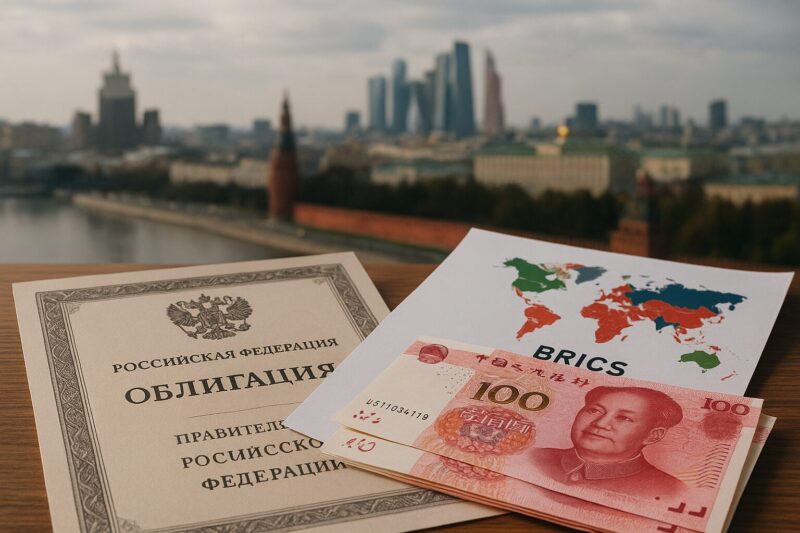Moscow’s yuan bonds mark Russia’s first-ever domestic debt issuance in Chinese currency, and officials actually scheduled the placement for December 8, 2025. The Finance Ministry plans to place up to 400 billion rubles ($4.9 billion) worth of yuan bond issuance on the Moscow Exchange with maturities ranging from three to seven years. A Russia budget deficit that ballooned to 5.7 trillion rubles ($63 billion)—nearly five times the original 2025 target—drives this historic shift, as BRICS energy funds increasingly flow through Chinese currency channels right now.
Also Read: China–ASEAN Pact Reshapes BRICS Trade as Yuan Hits New Milestone
How Moscow’s Yuan Bond Issuance Reshapes BRICS Energy Fund Flows


Russia Budget Deficit Drives Historic Yuan Debt Move
Russia’s budget deficit crisis is fueling Moscow’s unprecedented pivot to Moscow’s yuan bonds, and the numbers tell a stark story. Oil and gas revenues were down 20% year-on-year as of September, while customs duties also fell 19%. Value-added tax collections are projected to undershoot targets by 1.19 trillion rubles, along with profit tax revenues falling short by 167 billion rubles and recycling fees missing projections by 440 billion rubles.
One source familiar with the matter stated:
“The deal is planned for early December. They are aiming for the widest range of investors, from banks and asset management companies to brokers operating in the retail client market.”
The Finance Ministry has already been meeting with potential investors to promote the upcoming Moscow Yuan Bonds. A ministry official confirmed to Reuters that the Yuan Bond Issuance is in the works and officials will announce it soon, with order placements scheduled for December 2.
Finance Minister Anton Siluanov said:
“Previously, payments were in dollars and euros, with funds passing through Western banks that at some moment could stop these settlements.”
Siluanov added that Russia and China now conduct 99.1% of settlements in their own currencies, which enables both countries to avoid what he called “unfriendly foreign infrastructure” that links to the dollar- and euro-based banking systems.
BRICS Energy Funds Channel Into Yuan Instruments
Russia’s yuan debt is expected to be financed primarily by large state exporters like Rosneft and Lukoil that are earning revenue in Chinese currency. These oil giants are currently repatriating their yuan earnings before new U.S. sanctions take effect on November 21, 2025. The Moscow Exchange operates under Western sanctions at the time of writing, which actually makes Moscow’s yuan bonds a practical alternative for managing BRICS Energy Funds and the growing Russia budget deficit.
Dmitry Polevoy, head of investments at Astra Asset Management, stated:
“The main buyers will be residents, the demand for the finance ministry’s currency risk will be high, and there are more than enough yuan in the banking system.”
According to data from Cbonds, there are already 166 billion rubles ($2 billion) worth of yuan-denominated corporate bonds in circulation in Russia. Trade between Russia and China reached a record $245 billion last year, and even more significant is that 99.1% of settlements are now conducted in rubles and yuan.
Yuan Bond Issuance Marks Strategic Currency Pivot
Investors will pay for the bonds and receive coupon payments in both Yuan and rubles, which adds some flexibility to the instrument. Gazprombank, Sberbank, and VTB Capital—all under Western sanctions—will issue the bonds, and foreign investors, including those from China and other Asian countries, cannot access them. The government recently allowed state companies to invest their free funds on the domestic market, which includes government debt securities, and this policy channels BRICS energy funds accumulated through exports directly into yuan-denominated instruments.
Also Read: Why BRICS Is Abandoning the US Dollar?
This first-time sovereign yuan bond issuance marks a departure from traditional ruble-denominated debt instruments and signals how Moscow yuan Bonds could become a standard tool for managing Russia’s budget deficit pressures in the coming years. Polevoy noted that the issuance volume for the first two bond issues could be between an equivalent of $2 billion and $3 billion. The deficit gap—expanding from an initial forecast of 1.2 trillion rubles to 5.7 trillion—demonstrates the fiscal pressure that’s driving this innovation in government financing right now, as state exporters holding yuan reserves from energy sales now have domestic investment opportunities that align with their currency holdings and help channel Russia yuan debt into productive instruments.





